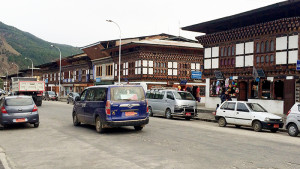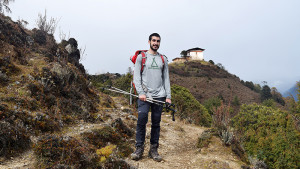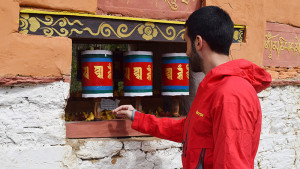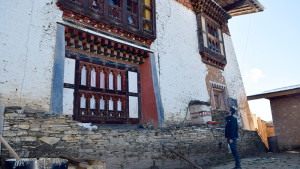Marking the start of a new series, our intrepid hiker, Fahd Abu Aisha, explores the stunning Druk Path Trek in Bhutan.
Day 1 – October 30th – The Long Journey to Shangri La
I booked this trip to Bhutan just like I booked my previous expedition climbing Mt. Elbrus in Russia; spontaneously.
Giving my gear list the brusque once-over, it was time to go. I was looking forward to the Chinese and Vietnamese itineraries that Dubai based bespoke adventure companyRahhalah had proposed, but it was Suzanne (the first Arab woman to summit Everest and the founder of Rahhalah) who urged me towards the Druk Path Trek, vowing the experience would be nothing short of divine. She always knows best, so I signed up blindly.
Again, as was the case with the Mt. Elbrus journey two months prior, work commitments were relentless and I ended up hurriedly packing with the urgency of one evacuating a warzone. A cruel, staggering Thursday night taxi ride to Sharjah sapped most of my energy by the time I got to the airport, and the long voyage to the Buddhist Kingdom hadn’t even begun to unfold. My flight was the following sequence: Sharjah to Kathmandu, and then on to Paro, Bhutan. It wasn’t the most inspirational of starts. I stuffed my face with Krispy Kreme donuts at the terminal in the hope that the sugar rush would keep me awake long enough to board the 3.30am Air Arabia flight to Kathmandu.
I passed out as soon as my head found a nook to cushion itself in against the plane window, and promptly plunged into a series of fantastical dreams of snowcapped peaks and gaping valleys. After what felt like a mere gasp of time, the nirvana I was engulfed in dissipated when the seemingly demure and chirpy plane stewardess swung the plane window open with the grace of a frantic fireman in a burning building. I withered furiously in my seat, my seething abruptly subsiding once I realised we were landing in Kathmandu.

It was hard to gather any sense of bearings at the airport other than the countless ‘Home of Mt. Everest’ posters that adorned every corridor. The Everest overdose was followed by a confused exchange with the immigration officer trying to find a blank page in my passport to stick the visa in. He resorted to sticking the visa in horizontally on a half full page.
My six hour layover at the airport predominantly comprised of me staring at the flight screen like a giddy child watching Cartoon Network. I gazed at the Paro flight information incessantly as it inched up the list of flights, feeling mounting convulsions with every status change from ‘Blank’ to ‘Check-In’ to ‘Boarding’.
As per usual, I passed out instantly on the Druk Air flight (flight narcolepsy- one of my many talents) while we were still on the runway. I was thankful I got to wake up 10 minutes before we had arrived at our destination, giving me time to peruse the terrain from above. I stared out of the window to find the plane’s wing weaving and swerving metres away from the mountains and the houses that peppered them. I could have waved to someone sitting in their living room it was that close. The landing was an experience in itself, as the small runway finally came into sight under some large hills. It demanded impressive technique to land in such a tight space.
I knew that this trip was going to be special as I strolled down the plane steps and onto the runway, shuffling into the terminal– all the while its striking Buddhist architecture had me convinced it was a temple. It was not until I had met my 3 guides that they informed me that Paro, (contrary to what I had thought) was not the capital city of Bhutan (that’s Thimpu), despite the international airport being based there. Rather, that was due to the land structure of the country. I was less surprised to hear that it had been described as the most difficult commercial airport in the world; with only a small number of airline pilots certified to operate commercial planes there.
The guides drove me through the city, enlightening me about this mysterious hermit Kingdom quietly nestled between India and China. Bhutan is the only country that measures its wealth on GNH – Gross National Happiness. Their system is monarchy based, their current King being of a fifth generation who rules over the country. His father who preceded him as the fourth King (and who is currently alive) recently implemented a democratic system establishing a parliament. Democracy is still a nascent concept in the state but ‘things are changing’ as was constantly re-iterated by the guides. Adherence to local culture and tradition is weakening and it may not be long before McDonalds or Starbucks begin spewing out their logos across those mountains. The Bhutan I saw might not be the same Bhutan in 10 years and that made me feel grateful I had the honour of experiencing it before the clutching grip of globalization took hold of this little nook.
After checking into my lodge, the guides took me into the town centre to do the obligatory tourist shopping. The shelves of the shops were embellished with beautiful Buddhist paintings, textiles and handicraft. One handicraft in particular caught my eye, and I learned of its importance in Buddhist culture as a symbol of good luck and to ward away any evil spirits.
We returned to the lodge where I was given a thorough briefing on the trek ahead and the route we would be embarking on. I was then treated to a delicious Bhutanese six course meal; dumplings, pumpkin curry, a mushroom and cheese dish, salad mixed with mint, grilled fish on a hill of spinach and steamed rice, topped with sugary rice pudding to put me into a food coma to conquer all food comas.
Day 2 – October 31st – Mud, Mountains and Monasteries
An uninterrupted 10-hour slumber later, I woke up refreshed, with a bowl of Bhutanese Chocos and some fulfilling omelets giving me all the energy I needed. My guide Tashi and the Driver picked me up and we drove up the valley to our starting point. As we ambled up, I saw specks of farmers tending to their rice paddy fields as the sun started to rise over the hills. Tashi joked that one of Bhutan’s many nicknames was the ‘Rice Bowl of Asia’.
The small watchtower Ta Dzong (overlooking the fortress Paro Dzong) signified the starting point of the trail. We parked on the slope, and started managing our gear. The Driver informed us that our chef and horseman (who would be tending to the horses carrying our supplies on the trail) were running late and we should wait in the car until they arrived. The Driver asked if I listened to English music and before I could answer him, he had switched on his MP3 telling me he loved Owl City. There was something surreal about listening to ‘When Can I See You Again’ amongst the backdrop of the Bhutanese mountains.
The chef and horseman arrived at the foot of the hill. Tashi advised that we should start our journey and let them catch up. And so we began, strolling up the slope flanked by traditional Bhutanese homes. One notable image I remember was seeing copious amounts of chilies left to dry on the roofs of the houses. The fruit is an important part of Bhutanese diet – and the Bhutanese eat these chilies like we eat grapes.
We continued to pace through houses and farms, making good enough time that Tashi decided we could wait on the trail until the chef and horseman (and horses naturally) caught up with us. This was also because otherwise we would have nothing to eat once we reached the first camp. As we waited, an elderly Bhutanese villager appeared on the trail behind us, walking at a slow gait. He decided to rest with us. I felt I was in one of Aesop’s Fables, and feared he would ask me to answer three riddles should I wish to cheat death. Instead he told us he was walking home but then fell asleep mid-sentence.
The weather was getting chilly and I braced myself for that infamous dilemma that I and every other adventurer like myself encounters on such excursions; holding the urge to go the bathroom once I get cozy in the sleeping bag, either burying my hands between my legs or braving the freezing ice blades stabbing my body as I pull myself outside of the tent and head to the makeshift toilet.
Standing still was making us cold so we agreed to walk at a slower pace in the hopes that the duo and their horses would catch up. We woke the old man who claimed he had been thinking deeply. He joined us on our walk for 15 minutes before disappearing on a side trail into the forest. The scenery was beautiful as trees as high as buildings and as old as 1000 years enveloped us. The chill in the air transformed into raindrops and within seconds it began to pour heavily. Inadequately dressed and frightened our gear was getting wet, we hustled to shelter under the roof of a farmer’s stable. The farmer was piling manure for her crops but still took time from her work to insist on providing us with a snack or drink, which we politely declined. We thanked her for her hospitality and told her we would be on our way once the rain subsided.
The rain did provide us with another period of rest, allowing the chef and horseman to finally catch up with us. As we greeted them the rain stopped and we continued on our trail. After a half hour walk through the dense trees there was a temporary opening under the sky. A large colourful structure stood before us. This, I was told in a gentle murmur by Tashi, was a Prayer Wheel. Prayer wheels are literally wheels with prayers written on them. Once spun, they are said to generate positive energy to answer said prayers and bring peace to the people in the land. I prayed I wouldn’t have to face my infamous dilemma once I got into my tent to sleep.
It was at these wheels, where we had our first officially planned break. I met an American couple from San Francisco who were on the same path. They were going on a tour around Asia, coming from India to trek the Druk Path before stopping over in Nepal for a few days and then flying back home. We shared stories of our travels before Tashi and I resumed our trail to the first camp site where they would be camping as well.
The walk had started to become a little more challenging when it started raining again. The path became muddier and slipperier. Another hour and a half later, we had finally slogged out of the forest and into the open plains. From the side of the plateau we stood on, we could see the town of Paro – a mere speck now – and on the other side; the monstrous snowcapped peaks of the Himalayan mountain range. Our camp was a few metres below the plateau but before we descended we made our way to the Jili Zhong Monastery, which lay perched on a cliff at the edge of the highland overlooking our camp and the mountains.
We hiked over to this secluded monastery to hear soothing Buddhist music echoing through the walls from a stereo. Tashi called out for the monk but no one answered as we explored the exterior of this seemingly abandoned temple. On the other side, we found a small cluster of huts, where a young man draped in a burgundy robe appeared and instructed me to remove my shoes as he unlocked the gate inside of the 15th century sanctuary. Taking pictures was prohibited, as much as I pleaded. I grudgingly relented and you only have my word to take for it, but it was beautiful. There was an eerie air of mysticism inside the altar room, as three giant golden Buddha statues sat staring ominously. The walls of the room were painted with the avatars of the many Buddhist Gods and the rays of light protruding through the curtains heightened the spiritual aura. Vibrantly coloured tapestries dangled from the ceiling and dozens of statues of the various Buddhist deities were shelved along the altar and the walls. We thanked the monk, and headed below the ridge to our campsite.
On the slope down, we ducked under what I thought to be a line of flags strung between the branches of the trees. I had a closer look and realised they were sheets of paper covered in Sanskrit. Tashi clarified that as the wind blew the sheets, it released positive energy into the air throughout the forest and the valley to ward off evil
spirits… and bears, he (semi) jokingly added. Without sounding superstitious, there was an eerie feeling of a force around us, something in the air I could not explain. There were also black bears lurking beyond the trail but they would only come out at night. Tashi would occasionally howl on the trail to make these bears, and other wild animals, aware of our presence. It’s common knowledge that loud noises scare off these brutish forest dwellers, I reminded myself to keep two pots near my sleeping bag at night.
It began to rain heavily and the temperature plummeted. I spent the remainder of the evening in the main tent, the smoke of the makeshift oven warming my knees. After another savoury dinner of crispy chicken drenched in mushroom and cheese sauce, I headed back to my tent and buried myself in my sleeping bag, praying I would sleep through this freezing night. (To be continued…)
Words + Photos by: Fahd Abu Aisha




